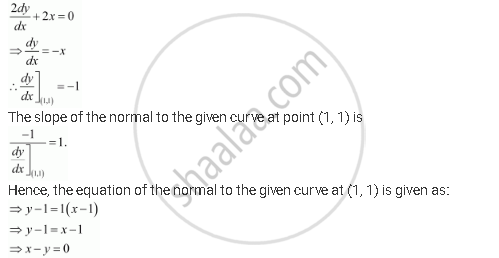Advertisements
Advertisements
प्रश्न
The normal at the point (1, 1) on the curve 2y + x2 = 3 is
(A) x + y = 0
(B) x − y = 0
(C) x + y + 1 = 0
(D) x − y = 1
उत्तर
The equation of the given curve is 2y + x2 = 3.
Differentiating with respect to x, we have:

The correct answer is B.
APPEARS IN
संबंधित प्रश्न
Using differentials, find the approximate value of the following up to 3 places of decimal
`(0.009)^(1/3)`
Using differentials, find the approximate value of the following up to 3 places of decimal
`(0.999)^(1/10)`
Using differentials, find the approximate value of the following up to 3 places of decimal
`(15)^(1/4)`
Using differentials, find the approximate value of the following up to 3 places of decimal
`(82)^(1/4)`
Using differentials, find the approximate value of the following up to 3 places of decimal
`(401)^(1/2)`
Using differentials, find the approximate value of the following up to 3 places of decimal
`(3.968)^(3/2)`
If the radius of a sphere is measured as 7 m with an error of 0.02m, then find the approximate error in calculating its volume.
If f (x) = 3x2 + 15x + 5, then the approximate value of f (3.02) is
A. 47.66
B. 57.66
C. 67.66
D. 77.66
The points on the curve 9y2 = x3, where the normal to the curve makes equal intercepts with the axes are
(A)`(4, +- 8/3)`
(B) `(4,(-8)/3)`
(C)`(4, +- 3/8)`
(D) `(+-4, 3/8)`
A circular metal plate expends under heating so that its radius increases by k%. Find the approximate increase in the area of the plate, if the radius of the plate before heating is 10 cm.
1 Using differential, find the approximate value of the following:
\[\sqrt{25 . 02}\]
Using differential, find the approximate value of the following: \[\left( 0 . 007 \right)^\frac{1}{3}\]
Using differential, find the approximate value of the \[\left( 255 \right)^\frac{1}{4}\] ?
Using differential, find the approximate value of the \[\frac{1}{(2 . 002 )^2}\] ?
Using differentials, find the approximate values of the cos 61°, it being given that sin60° = 0.86603 and 1° = 0.01745 radian ?
Using differential, find the approximate value of the \[\sin\left( \frac{22}{14} \right)\] ?
Using differential, find the approximate value of the \[\left( 29 \right)^\frac{1}{3}\] ?
Using differential, find the approximate value of the \[\sqrt{37}\] ?
Using differential, find the approximate value of the \[\left( 33 \right)^\frac{1}{5}\] ?
Using differential, find the approximate value of the \[\sqrt{36 . 6}\] ?
Find the approximate value of f (2.01), where f (x) = 4x2 + 5x + 2 ?
If the radius of a sphere is measured as 9 cm with an error of 0.03 m, find the approximate error in calculating its surface area ?
For the function y = x2, if x = 10 and ∆x = 0.1. Find ∆ y ?
If the percentage error in the radius of a sphere is α, find the percentage error in its volume ?
If there is an error of a% in measuring the edge of a cube, then percentage error in its surface is
While measuring the side of an equilateral triangle an error of k % is made, the percentage error in its area is
If loge 4 = 1.3868, then loge 4.01 =
The pressure P and volume V of a gas are connected by the relation PV1/4 = constant. The percentage increase in the pressure corresponding to a deminition of 1/2 % in the volume is
The approximate value of (33)1/5 is
Find the approximate values of : (3.97)4
Find the approximate values of (4.01)3
Find the approximate values of : e0.995, given that e = 2.7183.
Find the approximate values of : loge(9.01), given that log 3 = 1.0986.
The approximate value of the function f(x) = x3 − 3x + 5 at x = 1.99 is ____________.
If `(x) = 3x^2 + 15x + 5`, then the approximate value of `f(3.02)` is
Find the approximate value of sin (30° 30′). Give that 1° = 0.0175c and cos 30° = 0.866
